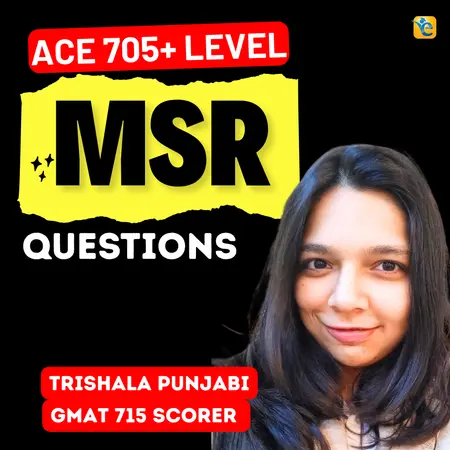Events & Promotions
|
|

GMAT Club Daily Prep
Thank you for using the timer - this advanced tool can estimate your performance and suggest more practice questions. We have subscribed you to Daily Prep Questions via email.
Customized
for You
Track
Your Progress
Practice
Pays
Not interested in getting valuable practice questions and articles delivered to your email? No problem, unsubscribe here.
- Nov 22
11:00 AM IST
-01:00 PM IST
Do RC/MSR passages scare you? e-GMAT is conducting a masterclass to help you learn – Learn effective reading strategies Tackle difficult RC & MSR with confidence Excel in timed test environment - Nov 23
11:00 AM IST
-01:00 PM IST
Attend this free GMAT Algebra Webinar and learn how to master the most challenging Inequalities and Absolute Value problems with ease. - Nov 25
10:00 AM EST
-11:00 AM EST
Prefer video-based learning? The Target Test Prep OnDemand course is a one-of-a-kind video masterclass featuring 400 hours of lecture-style teaching by Scott Woodbury-Stewart, founder of Target Test Prep and one of the most accomplished GMAT instructors.
Originally posted by shorteverything on 25 Jul 2010, 20:24.
Last edited by Bunuel on 09 Jun 2021, 01:08, edited 1 time in total.
Last edited by Bunuel on 09 Jun 2021, 01:08, edited 1 time in total.
Edited the question.
Kudos
Bookmarks
C
Be sure to select an answer first to save it in the Error Log before revealing the correct answer (OA)!
Difficulty:
 45%
(medium)
45%
(medium)
Question Stats:
68% (02:13) correct 32%
(02:11)
wrong
32%
(02:11)
wrong  based on 3431
sessions
based on 3431
sessions
History
Date
Time
Result
Not Attempted Yet
In the figure shown, what is the value of x?
(1) The length of line segment QR is equal to the length of line segment RS
(2) The length of line segment ST is equal to the length of line segment TU
Attachment:
Triangle.GIF [ 2.17 KiB | Viewed 362385 times ]
Kudos
Bookmarks
In the figure shown, what is the value of x?
\(x+\angle{QSR}+\angle{UST}=180\) (straight line =180) and \(\angle{R}+\angle{T}=90\) (as PRT is a right angle)
(1) The length of line segment QR is equal to the length of line segment RS --> triangle QRS is isosceles --> \(\angle{RQS}=\angle{QSR}=\frac{180-\angle{R}}{2}\) (as \(\angle{RQS}+\angle{QSR}+\angle{R}=180\) --> \(2*\angle{QSR}+\angle{R}=180\) --> \(\angle{QSR}=\frac{180-\angle{R}}{2}\)). Not sufficient.
(2) The length of line segment ST is equal to the length of line segment TU --> triangle UST is isosceles --> \(\angle{SUT}=\angle{UST}=\frac{180-\angle{T}}{2}\). Not sufficient.
(1)+(2) \(x+\angle{QSR}+\angle{UST}=180\) --> \(x+\frac{180-\angle{R}}{2}+\frac{180-\angle{T}}{2}=180\) --> \(x+\frac{360-(\angle{R}+\angle{T})}{2}=180\) --> since \(\angle{R}+\angle{T}=90\) --> \(x+\frac{360-90}{2}=180\) --> \(x=45\). Sufficient.
Answer: C.
Kudos
Bookmarks
From (1) RSQ = RQS
From (2) SUT = TSU
Because these 3 angles are on a straight line:
x + RSQ + TSU = 180
As all the angles of a quadrilateral sum up to 360:
x+90 + 180 - RSQ + 180 - TSU = 360
=> x + 360 - (RSQ + TSU) + 90 = 360
=> x + 90 -(180-x) = 0
=> 2x - 90 = 0
=> x = 45
So the answer is C.
From (2) SUT = TSU
Because these 3 angles are on a straight line:
x + RSQ + TSU = 180
As all the angles of a quadrilateral sum up to 360:
x+90 + 180 - RSQ + 180 - TSU = 360
=> x + 360 - (RSQ + TSU) + 90 = 360
=> x + 90 -(180-x) = 0
=> 2x - 90 = 0
=> x = 45
So the answer is C.













